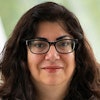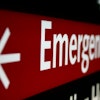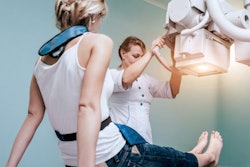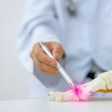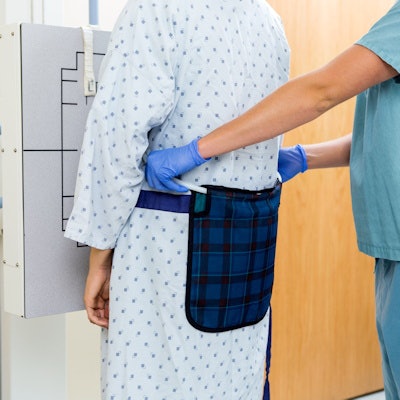
CHICAGO - Patients have come to expect a technician to drape their torsos with a heavy lead apron when they get an x-ray, but new thinking among radiologists and medical physicists is upending the decades-old practice of shielding patients from radiation.
Some hospitals are ditching the ritual of covering reproductive organs and fetuses during imaging exams after prominent medical and scientific groups have said it's a feel-good measure that can impair the quality of diagnostic tests and sometimes inadvertently increase a patient's radiation exposure.
The about-face is intended to improve care, but it will require a major effort to reassure regulators, healthcare workers, and the public that it's better not to shield.
Fear of radiation is entrenched in the collective psyche, and many people are surprised to learn that shielding can cause problems. The movement also has yet to gain much traction among dentists, whose offices perform more than half of all x-rays.
"There's this big psychological component, not only with patients but with staff," said Rebecca Marsh, PhD, a medical physicist at the University of Colorado Anschutz Medical Campus in Aurora, CO, who spoke about shielding at a December forum here at the annual meeting of the Radiological Society of North America. "How do you approach something that is so deeply ingrained in the minds of the healthcare community and the minds of patients?"
Covering testicles and ovaries during x-rays has been recommended since the 1950s, when studies in fruit flies prompted concern that radiation might damage human DNA and cause birth defects. Only in the past decade did radiology professionals start to reassess the practice, based on changes in imaging technology and a better understanding of radiation's effects.
Lead shields are difficult to position accurately, so they often miss the target area they are supposed to protect. Even when in the right place, they can inadvertently obscure areas of the body a doctor needs to see -- the location of a swallowed object, say -- resulting in a need to repeat the imaging process, according to the American Association of Physicists in Medicine, which represents physicists who work in hospitals.
Shields can also cause automatic exposure controls on an x-ray machine to increase radiation to all parts of the body being examined in an effort to "see through" the lead.
Moreover, shielding doesn't protect against the greatest radiation effect: "scatter," which occurs when radiation ricochets inside the body, including under the shield, and eventually deposits its energy in tissues.
Still, Dr. Cynthia Rigsby, a radiologist at Chicago's Ann & Robert H. Lurie Children's Hospital, called the move away from shielding a "pretty substantial" change. "I don't think it's going to happen overnight," she added.
Sweeping shift
In April, the physicists' association recommended that shielding of patients be "discontinued as routine practice." Its statement was endorsed by several groups, including the American College of Radiology and the Image Gently Alliance, which promotes safe pediatric imaging.
Around the same time, the Food and Drug Administration proposed removing from the federal code a 1970s recommendation to use shielding. A final rule is expected in September.
In the coming year, the National Council on Radiation Protection and Measurements, which gives guidance to regulatory bodies, is expected to release a statement supporting a halt to patient shielding.
However, experts continue to recommend that healthcare workers in the imaging area protect themselves with leaded barriers as a matter of occupational safety.
Groups in Canada and Australia have endorsed the change, and a movement to abandon lead shields is underway in Great Britain, according to Marsh.
Marsh, who's helping direct the educational effort, said perhaps a dozen U.S. hospitals have changed their official policies, but "most hospitals are starting to have the conversation."
Chicago's Lurie hospital is launching an "Abandon the Shield" campaign to educate staff, patients, and caregivers before it stops shielding across the organization this spring, Rigsby said. Shielding is used for most of the 70,000 x-ray procedures performed annually at Lurie in a variety of settings, from orthopedics to the emergency department.
A few miles away, at the University of Chicago Medicine hospitals, the recommendation to stop shielding "came as kind of a shock," said Dr. Kate Feinstein, chief of pediatric radiology.
Feinstein said it seems contrary to what radiology professionals are taught, and she's uncertain how it applies to her department, which already takes steps to reduce the chance that a shield will interfere with an exam. "We apply our shields correctly, and our technologists are incredibly well trained," she said.
Nevertheless, Feinstein said, her department is weighing a halt to routine shielding.
Some hospitals are concerned about violating state regulations. As of last spring, at least 46 states, including Illinois, required shielding of reproductive organs if they are close to the area being examined, unless shielding would interfere with the diagnostic quality of the exam, according to the medical physicists' association.
Some states are revising their regulations. In some cases, hospitals have applied for waivers or sidestepped state rules by taking the stance that a shield has the potential to affect diagnostic quality anytime it is used, Marsh said.
No evidence of benefit
The amount of radiation needed for an x-ray is about one-twentieth of what it was in the 1950s, and scientists have found no measurable harm to ovaries and testicles of patients from radiation exposure that comes from diagnostic imaging after decades of looking at data.
"What we know now is that there is likely no [hereditary] risk at all," said Dr. Donald Frush, a radiologist at Lucile Packard Children's Hospital Stanford in Palo Alto, CA, who chairs the Image Gently Alliance.
There's also no evidence that fetuses are harmed by even a relatively high amount of radiation exposure, such as that from a CT scan of the abdomen, Marsh said.
Nevertheless, some patients may insist on shielding. The physicists' group suggested that when hospitals craft their policies they consider that shielding may "calm and comfort."
"I don't think any of us are advocating to never use it," Frush said.
A need for outreach
Public confusion might develop if dentists continue to shield while hospitals don't. An estimated 275 million medical x-ray exams were performed in the U.S. in 2016, but 320 million dental x-rays were done.
Mahadevappa Mahesh, the chief physicist at Johns Hopkins Hospital, said there's been less outreach to dentists on the topic. "It's high time we bring them into the discussion," he said.
The American Dental Association states abdominal shielding "may not be necessary" but has continued to recommend using lead collars to shield the thyroid "whenever possible."
But Mahesh, who's on the board of the physicists' association, cautioned that lead collars to protect the thyroid may not be helpful and could obscure images taken by newer 3D dental imaging machines.
Contacted for a response, the dental association said its guidance on shielding is under review.
Technologists especially will need support in educating patients and families "so they are not feeling like they are walking into a disastrous conversation," said Marsh, the medical physicist.
She is doing her part. At the radiology conference, Marsh strummed a banjo and sang her version of the Woody Guthrie ballad "So Long, It's Been Good to Know Yuh," with lyrics like: "To get rid of shielding at first may seem strange, but the time is upon us to embrace this change."
Kaiser Health News is a nonprofit news service covering health issues. It is an editorially independent program of the Kaiser Family Foundation, which is not affiliated with Kaiser Permanente.
Copyright © 2020 Kaiser Health News. Licensed under CC BY-NC-ND 4.0.

